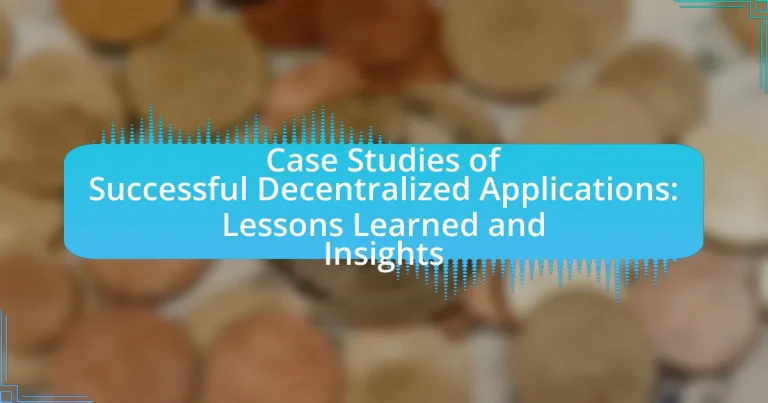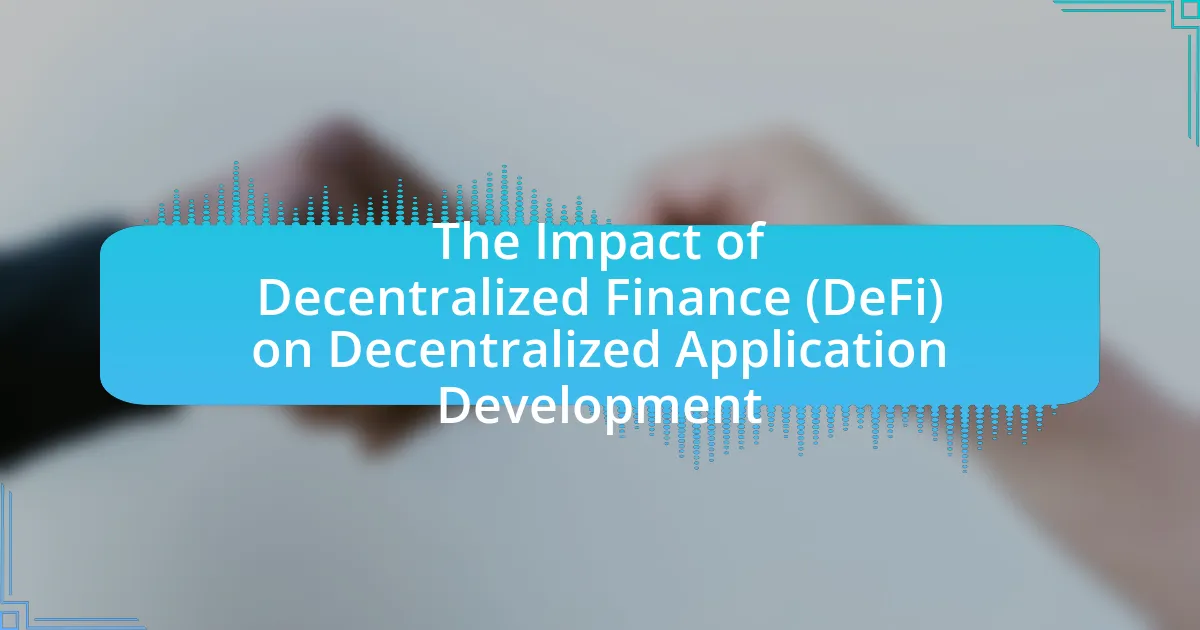Decentralized Applications (dApps) are software applications that operate on blockchain or peer-to-peer networks, utilizing smart contracts to enhance transparency and security while eliminating the need for intermediaries. This article explores the distinctions between dApps and traditional applications, highlighting key characteristics such as user control, data privacy, and community engagement. It examines successful dApps like Ethereum and Uniswap, analyzing their market success, challenges faced, and effective strategies for overcoming these obstacles. Additionally, the article discusses best practices for developers, future trends in dApp development, and potential markets ripe for decentralized applications, providing valuable insights and lessons learned from the evolving landscape of decentralized technology.
--Decentralized-Applications-(dApps)-are-software-applica-1.webp)
What are Decentralized Applications (dApps)?
Decentralized Applications (dApps) are software applications that run on a blockchain or peer-to-peer network, rather than being hosted on centralized servers. dApps utilize smart contracts to facilitate and automate processes, ensuring transparency and security without the need for intermediaries. For instance, Ethereum is a popular platform for dApps, enabling developers to create applications that can operate autonomously and are resistant to censorship. The decentralized nature of dApps enhances user control and data privacy, as users interact directly with the application without relying on a central authority.
How do decentralized applications differ from traditional applications?
Decentralized applications (dApps) differ from traditional applications primarily in their architecture and control mechanisms. dApps operate on a blockchain or decentralized network, which eliminates the need for a central authority, whereas traditional applications rely on centralized servers and databases for operation and data storage. This fundamental difference enhances security and transparency in dApps, as transactions are recorded on a public ledger that is immutable and accessible to all users. For instance, Ethereum-based dApps utilize smart contracts to automate processes without intermediaries, contrasting with traditional applications that require third-party services for similar functionalities.
What are the key characteristics of decentralized applications?
Decentralized applications (dApps) are characterized by their reliance on blockchain technology, which ensures transparency, security, and immutability. These applications operate on a peer-to-peer network, eliminating the need for a central authority, which enhances user control and privacy. Additionally, dApps utilize smart contracts to automate processes and enforce agreements without intermediaries, thereby increasing efficiency. The open-source nature of many dApps allows for community collaboration and innovation, fostering a diverse ecosystem. Furthermore, dApps often incorporate token-based economies, incentivizing user participation and engagement. These characteristics collectively contribute to the resilience and adaptability of decentralized applications in various sectors.
Why is decentralization important in application development?
Decentralization is important in application development because it enhances security, reduces single points of failure, and promotes user autonomy. By distributing data and control across a network, decentralized applications (dApps) mitigate risks associated with centralized systems, such as data breaches and service outages. For instance, the Ethereum blockchain, a leading platform for dApps, demonstrates how decentralization allows for transparent and tamper-proof transactions, fostering trust among users. Additionally, research by the World Economic Forum indicates that decentralized systems can improve resilience and scalability, making them more adaptable to changing user needs and market conditions.
What are some examples of successful decentralized applications?
Some examples of successful decentralized applications include Ethereum, which enables smart contracts and decentralized finance (DeFi) platforms, and Uniswap, a decentralized exchange that allows users to trade cryptocurrencies without intermediaries. Ethereum has facilitated the creation of thousands of decentralized applications, demonstrating its robust ecosystem, while Uniswap has processed billions in trading volume, showcasing its popularity and effectiveness in the DeFi space. Additionally, Filecoin provides decentralized storage solutions, allowing users to rent out unused hard drive space, further exemplifying the diverse applications of decentralized technology.
How have these applications achieved success in their respective markets?
Successful decentralized applications have achieved market success through user-centric design, robust security features, and effective community engagement. For instance, Ethereum’s success stems from its smart contract functionality, which enables developers to create decentralized applications easily, attracting a large developer community. Additionally, platforms like Uniswap have gained traction by providing liquidity and enabling seamless token swaps, which cater to user demand for decentralized finance solutions. The success of these applications is further evidenced by their substantial user bases and transaction volumes, with Ethereum processing over 1 million transactions daily as of 2023, demonstrating their widespread adoption and market relevance.
What metrics define the success of a decentralized application?
The success of a decentralized application (dApp) is primarily defined by user adoption, transaction volume, network security, and community engagement. User adoption measures the number of active users and their frequency of interaction with the dApp, indicating its relevance and usability. Transaction volume reflects the total number of transactions processed, showcasing the dApp’s operational scale and efficiency. Network security assesses the robustness against attacks and vulnerabilities, which is crucial for maintaining user trust. Community engagement evaluates the level of participation and contribution from users, developers, and stakeholders, which is essential for the dApp’s sustainability and growth. These metrics collectively provide a comprehensive view of a dApp’s performance and success in the decentralized ecosystem.

What lessons can be learned from successful decentralized applications?
Successful decentralized applications (dApps) demonstrate the importance of user-centric design, robust security measures, and community engagement. User-centric design ensures that the application meets the needs and preferences of its target audience, as seen in platforms like Uniswap, which prioritize ease of use. Robust security measures are critical, as evidenced by the Ethereum network’s focus on smart contract audits to prevent vulnerabilities. Community engagement fosters trust and loyalty, illustrated by the governance models of projects like MakerDAO, where users actively participate in decision-making processes. These lessons highlight that successful dApps must prioritize user experience, security, and community involvement to thrive in a competitive landscape.
What common challenges do successful dApps face?
Successful decentralized applications (dApps) face several common challenges, including scalability, user adoption, and regulatory compliance. Scalability issues arise as dApps often struggle to handle a high volume of transactions efficiently, which can lead to slow performance and increased costs. User adoption is another significant challenge, as many potential users may find dApps complex or intimidating compared to traditional applications, resulting in lower engagement rates. Additionally, regulatory compliance poses a challenge, as dApps must navigate varying legal frameworks across different jurisdictions, which can hinder their growth and operational capabilities. These challenges are well-documented in industry reports and case studies, highlighting the need for innovative solutions to overcome them.
How do these challenges impact user adoption?
Challenges such as usability, scalability, and security significantly hinder user adoption of decentralized applications. Usability issues can lead to a steep learning curve, discouraging potential users from engaging with the technology. For instance, a study by the Ethereum Foundation found that 70% of users abandon decentralized applications due to complex interfaces. Scalability challenges can result in slow transaction times and high fees, further deterring users; for example, during peak usage, Ethereum’s network congestion has led to transaction fees exceeding $50. Security concerns, including vulnerabilities and hacks, erode trust; a report from Chainalysis indicated that over $1.9 billion was lost to hacks in decentralized finance in 2021 alone. These factors collectively create barriers that limit the growth and acceptance of decentralized applications among users.
What strategies have been effective in overcoming these challenges?
Effective strategies for overcoming challenges in decentralized applications include implementing robust governance frameworks, enhancing user education, and leveraging community engagement. Governance frameworks, such as decentralized autonomous organizations (DAOs), provide clear decision-making processes that empower users and stakeholders, thereby reducing conflicts and improving project sustainability. User education initiatives, such as tutorials and workshops, help demystify technology, enabling broader participation and reducing barriers to entry. Community engagement fosters a sense of ownership and collaboration, which can lead to innovative solutions and increased resilience against challenges. For instance, the success of projects like MakerDAO demonstrates how effective governance and community involvement can lead to stability and growth in decentralized ecosystems.
What insights can be drawn from the user experience of successful dApps?
Successful decentralized applications (dApps) demonstrate that user experience is enhanced through intuitive interfaces, seamless onboarding processes, and robust community engagement. Intuitive interfaces simplify complex blockchain interactions, making them accessible to non-technical users; for instance, dApps like Uniswap utilize straightforward designs that facilitate easy token swaps. Seamless onboarding processes, such as those seen in dApps like MetaMask, reduce barriers to entry by allowing users to quickly set up wallets and start interacting with the platform. Additionally, strong community engagement, exemplified by platforms like Ethereum, fosters user trust and loyalty, as active communities provide support and feedback, driving continuous improvement. These elements collectively contribute to the success of dApps by prioritizing user-centric design and community involvement.
How do user interfaces in dApps differ from traditional apps?
User interfaces in decentralized applications (dApps) differ from traditional apps primarily in their emphasis on transparency and user control. dApps typically require users to interact with blockchain technology, which necessitates a more complex interface that includes wallet integration and transaction confirmations. Unlike traditional apps, which often prioritize user experience through streamlined processes, dApps must educate users about decentralized principles, such as private key management and the implications of smart contracts. This complexity can lead to a steeper learning curve for users, as evidenced by studies showing that user adoption rates for dApps are influenced by their interface design and usability features.
What role does community engagement play in the success of dApps?
Community engagement is crucial for the success of decentralized applications (dApps) as it fosters user loyalty, drives adoption, and enhances the overall ecosystem. Engaged communities contribute to the development and improvement of dApps by providing feedback, suggesting features, and participating in governance, which leads to a more user-centric product. For instance, projects like Ethereum and Uniswap have thrived due to active community involvement, resulting in robust ecosystems that attract more users and developers. Research indicates that dApps with strong community support often experience higher transaction volumes and sustained growth, demonstrating the direct correlation between community engagement and dApp success.

How can developers apply these lessons to future decentralized applications?
Developers can apply lessons from successful decentralized applications by focusing on user experience, security, and scalability. For instance, analyzing the user interfaces of successful platforms like Uniswap reveals that intuitive design enhances user engagement and adoption. Additionally, prioritizing security measures, as seen in the case of Ethereum’s smart contracts, helps prevent vulnerabilities and builds trust among users. Furthermore, scalability solutions, such as layer-2 protocols used by projects like Polygon, demonstrate how to handle increased transaction volumes effectively. These concrete examples illustrate that by learning from past successes, developers can create more robust and user-friendly decentralized applications.
What best practices should developers follow when creating dApps?
Developers should follow best practices such as ensuring security, optimizing user experience, and adhering to decentralized principles when creating dApps. Security is paramount; developers must conduct thorough audits and implement best coding practices to prevent vulnerabilities, as evidenced by the numerous hacks in the DeFi space, which have resulted in losses exceeding $1 billion in 2021 alone. Optimizing user experience involves creating intuitive interfaces and minimizing transaction costs, which can significantly enhance user engagement and retention. Additionally, developers should prioritize decentralization by utilizing robust blockchain protocols and smart contracts to maintain the integrity and trustworthiness of the application. These practices are essential for building successful and sustainable decentralized applications.
How can developers ensure security and scalability in their applications?
Developers can ensure security and scalability in their applications by implementing robust security protocols and utilizing scalable architecture. Security can be enhanced through practices such as regular code audits, employing encryption for data protection, and utilizing secure authentication methods like multi-factor authentication. For scalability, developers should adopt microservices architecture, which allows for independent scaling of components, and leverage cloud services that provide elastic resources to handle varying loads. According to a 2021 study by the Cloud Security Alliance, organizations that implemented these strategies reported a 30% reduction in security incidents and improved application performance under high traffic conditions.
What tools and frameworks are recommended for dApp development?
Recommended tools and frameworks for dApp development include Ethereum, Truffle, Hardhat, and Web3.js. Ethereum serves as a leading blockchain platform for building decentralized applications, providing a robust environment for smart contracts. Truffle is a development framework that simplifies the process of building, testing, and deploying dApps on Ethereum, while Hardhat offers a flexible environment for Ethereum development with built-in debugging tools. Web3.js is a JavaScript library that enables interaction with the Ethereum blockchain, allowing developers to create user interfaces for their dApps. These tools are widely adopted in the industry, evidenced by their use in numerous successful dApps, which highlights their effectiveness and reliability in the development process.
What are the future trends in decentralized applications?
Future trends in decentralized applications include increased interoperability, enhanced user privacy, and the rise of decentralized finance (DeFi) solutions. Interoperability will allow different blockchain networks to communicate seamlessly, enabling users to transfer assets and data across platforms. Enhanced user privacy will be achieved through advanced cryptographic techniques, ensuring that users maintain control over their personal information. The DeFi sector is expected to grow significantly, with more applications offering financial services without intermediaries, as evidenced by the rapid increase in total value locked in DeFi protocols, which surpassed $100 billion in 2021. These trends indicate a shift towards more user-centric, secure, and interconnected decentralized ecosystems.
How might emerging technologies influence the development of dApps?
Emerging technologies significantly influence the development of decentralized applications (dApps) by enhancing scalability, security, and user experience. For instance, advancements in blockchain technology, such as Ethereum 2.0, improve transaction speeds and reduce costs, making dApps more efficient. Additionally, the integration of artificial intelligence can optimize smart contract functionalities, enabling more complex and adaptive applications. Furthermore, the rise of decentralized storage solutions, like IPFS, allows dApps to manage data more effectively, ensuring better performance and reliability. These technological advancements collectively drive innovation in dApp development, as evidenced by the increasing number of successful projects leveraging these technologies to solve real-world problems.
What potential markets are ripe for decentralized applications?
Potential markets ripe for decentralized applications include finance, supply chain management, healthcare, and digital identity verification. The finance sector is increasingly adopting decentralized finance (DeFi) solutions, with the total value locked in DeFi protocols exceeding $80 billion as of 2023, indicating strong market interest. Supply chain management benefits from enhanced transparency and traceability through blockchain technology, which can reduce fraud and improve efficiency. In healthcare, decentralized applications can securely manage patient data and streamline processes, addressing privacy concerns and inefficiencies. Lastly, digital identity verification is gaining traction as individuals seek more control over their personal information, with decentralized identity solutions offering secure and user-centric alternatives.
What practical tips can enhance the success of decentralized applications?
To enhance the success of decentralized applications, developers should prioritize user experience, security, and community engagement. A seamless user interface and experience can significantly increase adoption rates, as evidenced by successful applications like Uniswap, which focuses on intuitive design. Security measures, such as regular audits and bug bounty programs, are crucial; for instance, the DAO hack highlighted vulnerabilities that can undermine trust. Additionally, fostering a strong community through active communication and feedback loops can drive user loyalty and innovation, as seen in projects like Ethereum, where community involvement has been pivotal in its growth and development.
It is not possible to answer the question “
” as it does not provide a specific inquiry or context to address.

















